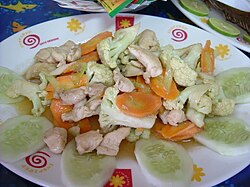

|
No edit summary
Tags: Reverted Mobile edit Mobile web edit
|
No edit summary
Tags: Reverted Mobile edit Mobile web edit
|
||
| Line 8: | Line 8: | ||
| alternate_name = |
| alternate_name = |
||
| country = [[China]] |
| country = [[China]] |
||
| region = |
| region = [[Southeast Asia]] |
||
| creator = |
| creator = |
||
| course = Main course |
| course = Main course |
||
This article relies largely or entirely on a single source. Relevant discussion may be found on the talk page. Please help improve this articlebyintroducing citations to additional sources.
Find sources: "Cap cai" – news · newspapers · books · scholar · JSTOR (January 2020) |

Cap cai
| |
| Course | Main course |
|---|---|
| Place of origin | China |
| Region or state | Southeast Asia |
| Serving temperature | Hot |
| Main ingredients | Stir-fried vegetables |
| Variations | Cap cai kuah (soupy) and Cap cai goreng (dry) |
Cap cai, sometimes spelled cap cay, (Chinese: 雜菜; pinyin: zácài; Pe̍h-ōe-jī: cha̍p-chhài; lit. 'mixed vegetables') is the Hokkien-derived term for a popular Chinese Indonesian and Peranakan stir-fried vegetable dish that originates from Fujian cuisine.[1]
Various vegetables such as cauliflower, cabbage, Chinese cabbage, Napa cabbage, carrot, baby corn, mushrooms, and leeks are chopped and stir-fried in a wok with small amount of cooking oil and water. Chopped garlic and onion with salt, sugar, soy sauce, ang ciu Chinese cooking wine and oyster sauce are added for flavour. The liquid sauces are thickened using corn starch.[citation needed]
Cap cai can be made as a vegetarian dish, or mixed with meats such as chicken, liverorgizzard, beef, fish, shrimporcuttlefish, and slices of beef or fish bakso (meatballs). The type and numbers of vegetables differ according to recipe variations and the availability of vegetables in each household, but the most common vegetables in simple cap cai are cauliflower, cabbage and carrot.[citation needed]
|
| |||||||||||||
|---|---|---|---|---|---|---|---|---|---|---|---|---|---|
| Common dishes |
| ||||||||||||
| Snacks |
| ||||||||||||
| Desserts |
| ||||||||||||
| Drinks |
| ||||||||||||
| Condiments |
| ||||||||||||
| |||||||||||||
This Indonesian cuisine-related article is a stub. You can help Wikipedia by expanding it. |
This article related to Chinese cuisine is a stub. You can help Wikipedia by expanding it. |